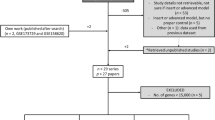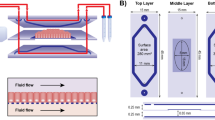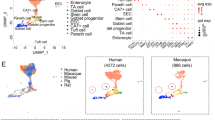Abstract
Purpose. The purpose of this work was to study the influence of cell differentiation on the mRNA expression of transporters and channels in Caco-2 cells and to assess Caco-2 cells as a model for carrier-mediated drug transport in the intestines.
Method. Gene mRNA expression was measured using a custom-designed microarray chip with 750 deoxyoligonucleotide probes (70mers). Each oligomer was printed four times on poly-lysine-coated glass slides. Expression profiles were expressed as ratio values between fluorescence intensities of Cy3 and Cy5 dye-labeled cDNA derived from poly(A) + RNA samples of Caco-2 cells and total RNA of human intestines.
Results. Significant differences in the mRNA expression profile of transporters and channels were observed upon differentiation of Caco-2 cells from 5 days to 2 weeks in culture, including changes for MAT8, S-protein, and Nramp2. Comparing Caco-2 cells of different passage number revealed few changes in mRNAs except for GLUT3, which was down-regulated 2.4-fold within 13 passage numbers. Caco-2 cells had a similar expression profile when either cultured in flasks or on filters but differed more strongly from human small and large intestine, regardless of the differentiation state of Caco-2 cells. Expression of several genes highly transcribed in small or large intestines differed fourfold or more in Caco-2 cells.
Conclusions. Although Caco-2 cells have proven a suitable model for studying carrier-mediated transport in human intestines, the expression of specific transporter and ion channel genes may differ substantially.
Similar content being viewed by others
REFERENCES
P. Stenberg, K. Luthman, and P. Artursson. Virtual screening of intestinal drug permeability. J. Control. Release. 65:231-243 (2000).
J. C. Venter, M. D. Adams, E. W. Myers, P. W. Li, R. J. Mural, G. G. Sutton, H. O. Smith, M. Yandell, C. A. Evans, R. A. Holt, et al. The sequence of the human genome. Science 291:1304-1351 (2001).
V. H. Lee. Membrane transporters. Eur. J. Pharm. Sci. 11:S41-S50 (2000).
A. Tsuji and I. Tamai. Carrier-mediated intestinal transport of drugs. Pharm. Res. 13:963-977 (1996).
H. Han, R. L. de Vrueh, J. K. Rhie, K. M. Covitz, P. L. Smith, C. P. Lee, D. M. Oh, W. Sadee, and G. L. Amidon. 5′-Amino acid esters of antiviral nucleosides, acyclovir, and AZT are absorbed by the intestinal PEPT1 peptide transporter. Pharm. Res. 15:1154-1159 (1998).
M. E. Ganapathy, M. Brandsch, P. D. Prasad, V. Ganapathy, and F. H. Leibach. Differential recognition of beta-lactam antibiotics by intestinal and renal peptide transporters, PEPT 1 and PEPT 2. J. Biol. Chem. 270:25672-25677 (1995).
H. Takanaga, I. Tamai, and A. Tsuji. pH-dependent and carrier-mediated transport of salicylic acid across Caco-2 cells. J. Pharm. Pharmacol. 46:567-570 (1994).
I. Tamai, H. Takanaga, H. Maeda, Y. Sai, T. Ogihara, H. Higashida, and A. Tsuji. Participation of a proton-cotransporter, MCT1, in the intestinal transport of monocarboxylic acids. Biochem. Biophys. Res. Commun. 214:482-489 (1995).
S. Hoffmeyer, O. Burk, O. von Richter, H. P. Arnold, J. Brockmoller, A. Johne, I. Cascorbi, T. Gerloff, I. Roots, M. Eichelbaum, et al. Functional polymorphisms of the human multidrug-resistance gene: multiple sequence variations and correlation of one allele with P-glycoprotein expression and activity in vivo. Proc. Natl. Acad. Sci. USA 97:3473-3478 (2000).
M. M. Gottesman, T. Fojo, and S. E. Bates. Nat. Rev. Cancer 2:48-58 (2002).
P. Artursson, K. Palm, and K. Luthman. Caco-2 monolayers in experimental and theoretical predictions of drug transport. Adv. Drug Deliv. Rev. 46:27-43 (2001).
H. Lennernas. Human intestinal permeability. J. Pharm. Sci. 87:403-410 (1998).
M. J. Engle, G. S. Goetz, and D. H. Alpers. Caco-2 cells express a combination of colonocyte and enterocyte phenotypes. J. Cell Physiol. 174:362-369 (1998).
S. Brown and W. Sadee. A semi-automated approach to gene discovery through EST data mining: Discovery of new human transporter genes. AAPS Pharm. Sci. 3:E9(2002).
P. K. Rathod, K. Janesan, R. E. Hayward, Z. Bozdeck, and J. L. DeRisi. DNA microarrays for malaria. Trends Parasitol. 18:39-45 (2002).
J. L. DeRisi, V. R. Iyer, and P. O. Brown. Exploring the metabolic and genetic control of gene expression on a genomic scale. Science 278:680-686 (1997).
D. Herrera-Ruiz, Q. Wang, O. S. Gudmundsson, T. J. Cook, R. L. Smith, T. N. Faria, and G. T. Knipp. Spatial expression patterns of peptide transporters in the human and rat gastrointestinal tracts, Caco-2 in vitro cell culture model, and multiple human tissues. AAPS Pharm. Sci. 3:E9(2001).
J. D. Horisberger. Electrogenic Transepithelial Na+ Transport in the Colon. In K. E. Barrett, and M. Donowitz (eds.), Gastrointestinal Transport: Molecular Physiology, Volume 50, Academic Press, San Diego, California 2001 pp 413-425.
D. G. Silberg, W. Wang, R. H. Moseley, and P. G. Traber. The Down regulated in Adenoma (dra) gene encodes an intestine-specific membrane sulfate transport protein. J. Biol Chem. 270:11897-11902 (1995).
W. S. Lee, Y. Kanai, R. G. Wells, and M. A. Hediger. The high affinity Na+/glucose cotransporter. Re-evaluation of function and distribution of expression. J. Biol. Chem. 269:12032-12039 (1994).
M. Agnel, T. Vermat, and J. M. Culouscou. Identification of three novel members of the calcium-dependent chloride channel (CaCC) family predominantly expressed in the digestive tract and trachea. FEBS Lett. 455:295-301 (1999).
H. Yano, Y. Seino, N. Inagaki, Y. Hinokio, T. Yamamoto, K. Yasuda, K. Masuda, Y. Someya, and H. Imura. Tissue distribution and species difference of the brain type glucose transporter (GLUT3). Biochem. Biophys. Res. Commun. 174:470-477 (1991).
P. Anderle, E. Niederer, W. Rubas, C. Hilgendorf, H. Spahn-Langguth, H. Wunderli-Allenspach, H. P. Merkle, and P. Langguth. P-Glycoprotein (P-gp) mediated efflux in Caco-2 cell monolayers: the influence of culturing conditions and drug exposure on P-gp expression levels. J. Pharm. Sci. 87:757-762. (1998).
A. Mordrelle, E. Jullian, C. Costa, E. Cormet-Boyaka, R. Benamouzig, D. Tome, and J. F. Huneau. EAAT1 is involved in transport of L-glutamate during differentiation of the Caco-2 cell line. Am. J. Physiol. 279:G366-373 (2000).
M. Pan, M. Malandro, and B. R. Stevens. Regulation of system y+ arginine transport capacity in differentiating human intestinal Caco-2 cells. Am. J. Physiol. 268:G578-585 (1995).
L. Mahraoui, M. Rousset, E. Dussaulx, D. Darmoul, A. Zweibaum, and E. Brot-Laroche. Expression and localization of GLUT-5 in Caco-2 cells, human small intestine, and colon. Am. J. Physiol. 263:G312-G318 (1992).
V. Bohner. Mechanisms and Pathways of Intestinal Peptide Absorption: Permeation, Metabolism and Secretion, Eidgenössische Technische Hochschule Zurich, 1996 pp 84-85.
R. J. Wood and O. Han. Recently identified molecular aspects of intestinal iron absorption. J. Nutr. 128:1841-1844 (1998).
B. W. Morrison, J. R. Moorman, G. C. Kowdley, Y. M. Kobayashi, L. R. Jones, and P. Leder. Mat-8, a novel phospholemman-like protein expressed in human breast tumors, induces a chloride conductance in Xenopus oocytes. J. Biol. Chem. 270:2176-2182 (1995).
S. Honore, V. V. Pichard, C. Penel, V. Rigot, C. Prev t, J. Marvaldi, C. Briand, and J. B. Rognoni. Outside-in regulation of integrin clustering processes by ECM components per se and their involvement in actin cytoskeleton organization in a colon adenocarcinoma cell line. Histochem. Cell Biol. 114:323-335 (2000).
S. J. Keely and K. E. Barrett. Integrated signaling mechanisms that regulate intestinal chloride secretion. In K. E. Barrett and M. Donowitz (eds.), Gastrointestinal Transport: Molecular Physiology, Volume 50, Academic Press, San Diego, California 2001 pp 249-299.
D. S. Harris, J. W. Slot, H. J. Geuze, and D. E. James. Polarized distribution of glucose transporter isoforms in Caco-2 cells. Proc. Natl. Acad. Sci. USA 89:7556-7560 (1992).
T. Yamamoto, Y. Seino, H. Fukumoto, G. Koh, H. Yano, N. Inagaki, Y. Yamada, K. Inoue, T. Manabe, and H. Imura. Over-expression of facilitative glucose transporter genes in human cancer. Biochem. Biophys. Res. Commun. 170:223-230 (1990).
T. R. Ziegler, C. Fernandez-Estivariz, L. H. Gu, N. Bazargan, K. Umeakunne, T. M. Wallace, E. E. Diaz, K. E. Rosado, R. R. Pascal, J. R. Galloway, et al. Distribution of the H+/peptide transporter PepT1 in human intestine: up-regulated expression in the colonic mucosa of patients with short-bowel syndrome. Am. J. Clin. Nutr. 75:922-930 (2002).
Author information
Authors and Affiliations
Corresponding author
Rights and permissions
About this article
Cite this article
Anderle, P., Rakhmanova, V., Woodford, K. et al. Messenger RNA Expression of Transporter and Ion Channel Genes in Undifferentiated and Differentiated Caco-2 Cells Compared to Human Intestines. Pharm Res 20, 3–15 (2003). https://doi.org/10.1023/A:1022282221530
Issue Date:
DOI: https://doi.org/10.1023/A:1022282221530




